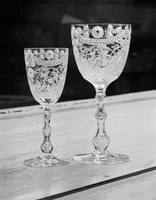 | Back to e-WV
| Back to e-WV
 The West Virginia Encyclopedia
The West Virginia Encyclopedia
 | Back to e-WV
| Back to e-WV
 The West Virginia Encyclopedia
The West Virginia Encyclopedia

In 1891, a group of glassworkers, largely neighbors from the Black Forest area of Germany, opened the Seneca Glass Company in Fostoria, Ohio, in a factory recently vacated by Fostoria Glass Company’s relocation to Moundsville. In 1896, Seneca Glass followed Fostoria to West Virginia. Seneca selected Morgantown, becoming the first of more than 20 glass factories to operate there. By the next year Seneca employed 250 workers.
From the beginning Seneca created quality, hand-blown lead glass. Early price lists show tumblers, bar bottles, pitchers, decanters, covered candy jars, nappies, finger bowls, sugar and creamers, water sets, vases, and endless varieties of stemware. Seneca used nearly every decorating technique. Glass was sand-blasted, acid-etched, plate-etched, needle-etched, hand-cut, and in other ways embellished.
The company opened a second factory in nearby Star City in 1911. Following national trends, Seneca added colored lead glass in the 1920s and produced colored glass until closing in 1983. Seneca specialized in high-end, elegant cut glass. In the most elaborate patterns 14 hours could be spent in cutting a single goblet, resulting in an expensive piece.
Such elegant glass attracted clientele from around the globe. Many U.S. embassies ordered Seneca Glass; the president of Liberia chose Seneca, as did U.S. Vice-President Lyndon Johnson. Seneca was the last elegantly cut American lead crystal sold by Tiffany’s as the demand for expensive cut crystal faded. Today the factory along the Monongahela River houses a shopping complex while retaining the architecture and some artifacts from one of the world’s finest glass houses.
Written by Dean Six
Page, Bob & Dale Frederiksen. Seneca Glass Company 1891-1983. Greensboro, NC: Page-Frederiksen Pub., 1995.
Six, Dean. Decorating Techniques at Seneca Glass. Glass Collector's Digest, (Apr.-May 1991).